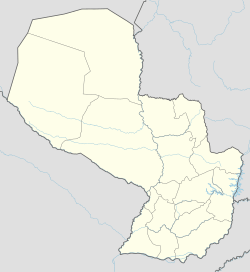Itá, Paraguay facts for kids
Quick facts for kids
Itá
|
||
|---|---|---|
|
District & City
|
||
|
||
| Country | Paraguay | |
| Department | Central | |
| Founded | 1539 by Domingo Martínez de Irala | |
| Area | ||
| • Total | 183.84 km2 (70.98 sq mi) | |
| Elevation | 101 m (331 ft) | |
| Population
(2016)
|
||
| • Total | 75,606 | |
| • Density | 265/km2 (690/sq mi) | |
| Time zone | -4 Gmt | |
| Postal code |
2710
|
|
| Area code(s) | (595) (24) | |
| Climate | Cfa | |
Itá is a city and district in Paraguay. It is located in the Central Department, about 35 kilometers (22 miles) from the capital city, Asunción. Itá is known for its rich history and unique traditions.
Contents
What Does "Itá" Mean?
The name "Itá" comes from the Guaraní language. It means "stone." This name might come from the hills in the background that look like stones. Itá is also called the "Capital of Ceramics."
Itá's Climate
Itá has a warm climate. In summer, the temperature can reach 40°C (104°F). In winter, it can drop to 0°C (32°F). The average temperature in the Central Department is around 22°C (72°F). It rains a lot from January to April. The driest months are from June to August.
How Many People Live in Itá?
According to recent numbers, Itá has about 81,084 residents. This includes roughly 40,708 males and 40,377 females.
Itá's History
Itá was founded in 1539 by Governor Domingo Martínez de Irala. It was first a town where Guaraní people lived. It became an official district in 1884.
The people of Itá have a mix of cultures and traditions. Many of these unique customs have been passed down through generations.
Itá is often called the "city of pitchers and honey." This nickname started when Franciscan friars taught women how to make clay pots. These pots were called "pitchers." The production of honey from sugarcane also began with the first settlers.
The Legend of Itá Lagoon
There are interesting stories about the Itá Lagoon. One legend says that during a war, an old woman refused to share water from her well with thirsty soldiers. Because of this, a flood came and covered her house, forming the lagoon.
Another story says that a golden bell is buried in the lagoon. People believe it was hidden there during wartime. This was done so invaders could not take it as a prize.
Communities in Itá
Itá is made up of several communities. Each community has its own population.
| Name | Population |
|---|---|
| Yjhovy | 1435 |
| Potrero Po’i | 2046 |
| Itá Potrero | 1063 |
| Valle Jo’a | 245 |
| Oculto Chircaty | 780 |
| Arrua’i | 2833 |
| Curupicayty | 1468 |
| Peguaho | 1289 |
| Jhugua Ñaró | 1185 |
| Calle Ybaté | 1185 |
| Calle Po’i | 193 |
| Tapé Tuyá | 497 |
| Posta Gaona | 1591 |
| Aveiro | 2033 |
| Caaguazu'i | 2204 |
| Caraguataity | 286 |
| Las Piedras | 2507 |
Itá's Neighborhoods
The city of Itá has several neighborhoods.
| Name |
|---|
| Neighborhood San Blas |
| Neighborhood Sportivo |
| Neighborhood Cerro Corá |
| Neighborhood San Antonio |
| Neighborhood Villa Rossana I and II |
| Neighborhood Paranambu |
| Neighborhood San Cayetano |
| Neighborhood San Miguel |
Itá's Economy
The people of Itá mainly work in agriculture and pottery. They are famous for their unique black pottery. Recently, adventure tourism has also become popular in the Arruaí area.
Getting Around Itá
Itá is about 37 kilometers (23 miles) from Asunción. You can reach it by taking Route 1, also known as Mariscal Francisco Solano López. Another way to get there is through the "Southern Access" route. From Itá, you can also take a detour to visit nearby towns like Itauguá and Guarambaré.
Fun Things to Do in Itá
Itá is a great place to visit. It has many interesting sights and activities.
- Handicrafts: The city is known for its traditional crafts. You can find beautiful ceramics and baskets.
- San Blas Craft Center: This center is in the city center on Route 1. It has a permanent display of pottery and ceramics. You can see Guaraní-Hispanic designs, pitchers, and blankets.
- Local Market: Visit the market for delicious seafood meals. It's known for its unique flavors.
- Itá Lagoon: This lagoon is also called "Acosta Ñú Martyrs." It has never dried up and is a very special place.
- Cerro Arrúa'i Cave: This mysterious cave is a beautiful spot. You can also find resorts along the Arroyo Paranambú.
- San Blas Church: This historic Franciscan church dates back to 1698. It is considered a very important historical building.
- Adventure Tourism: In the Arruaí area, you can enjoy adventure activities. These include fishing, photo safaris, and exploring the path of former Mariscal López. You can also find camps and places to stay.
Famous People from Itá
Itá is home to several talented people.
- Rosa Brítez: A famous potter known as the "Potter of América."
- Juana Marta Rodas and Julia Isídrez: These ceramists won the Dutch "Prince Claus Award" for their amazing work.
- Elvis Marecos: A professional football (soccer) player.
- Marcelo Fernández: Another professional football (soccer) player.
- Jorge Guasch: A professional football (soccer) player.
Images for kids
See also
 In Spanish: Itá para niños
In Spanish: Itá para niños





